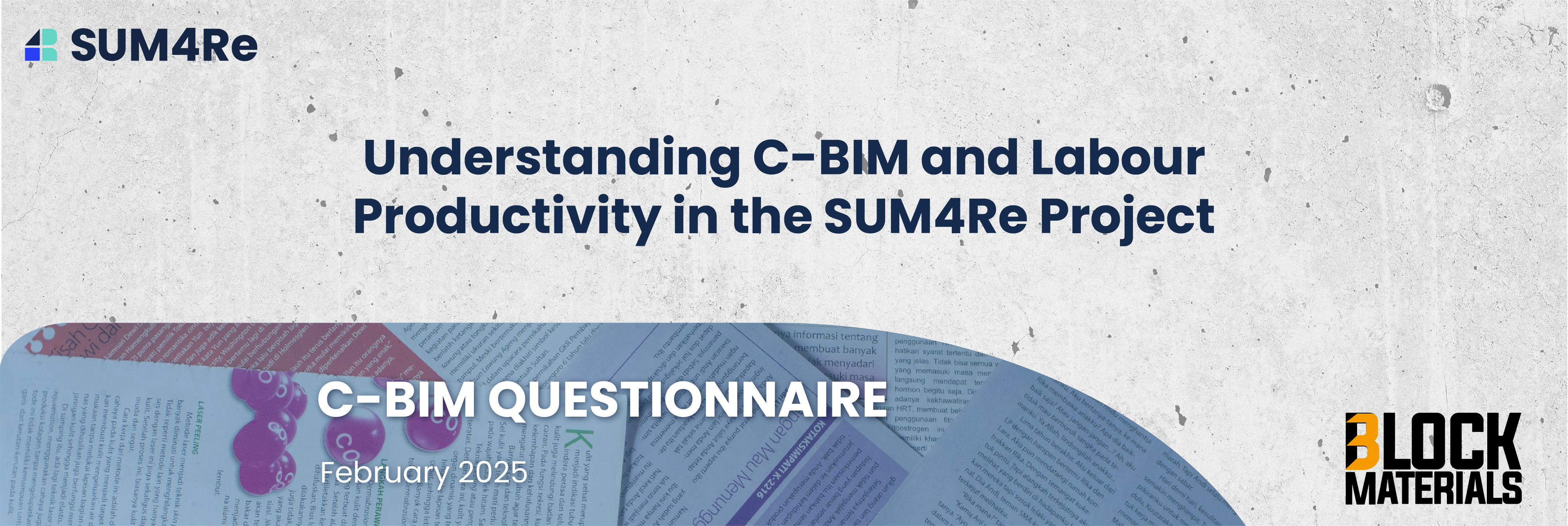At the start of a project like SUM4RE, many new concepts and challenges are introduced. Everyone also looks at all these concepts and challenges differently, given their own background and expertise. This also leads to confusion, miscommunication, and the wrong use of resources in daily work. To prevent this, we will also have to work on mutual understanding, including education and explanation of what exactly we mean by something.
In the SUM4RE project, this occurs, for example, around the concept of C-BIM. A concept that is mentioned 84 times in the application, but has not yet been further elaborated. The questionnaire Understanding C-BIM was deployed within the project group to activate the “wisdom of the crowds”. Based on 20 questions, many of which also originated from the text of the application, 19 participants of SUM4RE were ultimately asked what C-BIM means.Apart from the fact that C-BIM does not stand for Cloud-BIM, but for Circular BIM, the results indicated that C-BIM can be given substance, but not for everyone. Of the 19 participants, approximately 8 people appeared to be able to participate in the questions for this moment, and can also contribute to the further elaboration thereof. The remaining participants will be connected when the core group has also given more body to the various elaborations of C-BIM.
After all, the results of the survey also clearly show that there are two trends to give C-BIM for. On the one hand, the group sees C-BIM as an extension of the current use of BIM in the construction world, and on the other hand, the group that sees C-BIM as an independent information issue for materials that are released from buildings. And must be passed on by expert demolition in the future for use in a new building. An issue in which not the building, but the transaction of the materials from the present to the future is central.
Understanding Labour Productivity in SUM4RE
An important central objective of the SUM4RE project is to investigate methods, techniques
and instruments for their labour productivity. That is to say, they help us to make the
information about a building and its materials transparent faster and better than is currently
done on the basis of a manual inventory.
Improving labour productivity can be achieved through different types of interventions:
a. Increasing the competences of employees. Both with regard to their own possibilities
to map buildings and materials manually, and training them in instruments, techniques
and methods (from SUM4RE) with which buildings and materials are mapped.
b. Preventing market inefficiencies. This intervention means that activities are performed
that allow supply and demand for goods and services to better reach each other. In a
circular economy and SUM4RE of great importance, given the issue of information
asymmetry between sellers and buyers of materials with regard to the quality of
materials. If the quality is known, secondary materials have a high value, if it is not
known, it is much lower.
c. Innovation. By using new technologies and instruments, manual inventory of buildings
and materials can be replaced, or reorganized, whereby routine tasks are replaced by
more complex tasks that require the use of people. It creates the space for people to
perform more profitable or tasks with a higher labor productivity.
For each of the instruments, technologies, or methodologies in the project will (try to) find out
how productive they are with regard to the inventory of materials in a building and the reuse
of these materials. This is partly an iterative process because not all questions in this
questionnaire can be answered directly. Studying the answers and summarizing the results
will hopefully provide direction to everyone in SUM4RE in carrying out the work in the work
areas and applying the instruments, technologies, and methodologies in the pilots. The
results are going to be expected in February 2025.

